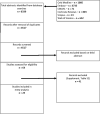Inhaled Prostacyclins for Acute Respiratory Distress Syndrome: A Systematic Review and Meta-Analysis
- PMID: 37303944
- PMCID: PMC10256381
- DOI: 10.1097/CCE.0000000000000931
Inhaled Prostacyclins for Acute Respiratory Distress Syndrome: A Systematic Review and Meta-Analysis
Abstract
Studies evaluating inhaled prostacyclins for the management of acute respiratory distress syndrome (ARDS) have produced inconsistent results regarding their effect on oxygenation. The purpose of this systematic review and meta-analysis was to evaluate the change in the Pao2/Fio2 ratio after administration of an inhaled prostacyclin in patients with ARDS.
Data sources: We searched Ovid Medline, Embase, Cumulative Index to Nursing and Allied Health Literature, Cochrane, Scopus, and Web of Science.
Study selection: We included abstracts and trials evaluating administration of inhaled prostacyclins in patients with ARDS.
Data extraction: Change in the Pao2/Fio2 ratio, Pao2, and mean pulmonary artery pressure (mPAP) were extracted from included studies. Evidence certainty and risk of bias were evaluated using Grading of Recommendations Assessment, Development, and Evaluation and the Cochrane Risk of Bias tool.
Data synthesis: We included 23 studies (1,658 patients) from 6,339 abstracts identified by our search strategy. The use of inhaled prostacyclins improved oxygenation by increasing the Pao2/Fio2 ratio from baseline (mean difference [MD], 40.35; 95% CI, 26.14-54.56; p < 0.00001; I2 = 95%; very low quality evidence). Of the eight studies to evaluate change in Pao2, inhaled prostacyclins also increased Pao2 from baseline (MD, 12.68; 95% CI, 2.89-22.48 mm Hg; p = 0.01; I2 = 96%; very low quality evidence). Only three studies evaluated change in mPAP, but inhaled prostacyclins were found to improve mPAP from baseline (MD, -3.67; 95% CI, -5.04 to -2.31 mm Hg; p < 0.00001; I2 = 68%; very low quality evidence).
Conclusions: In patients with ARDS, use of inhaled prostacyclins improves oxygenation and reduces pulmonary artery pressures. Overall data are limited and there was high risk of bias and heterogeneity among included studies. Future studies evaluating inhaled prostacyclins for ARDS should evaluate their role in ARDS subphenotypes, including cardiopulmonary ARDS.
Keywords: acute respiratory distress syndrome; mechanical ventilation; meta-analysis; oxygenation; prostacyclin; pulmonary vasodilator.
Copyright © 2023 The Authors. Published by Wolters Kluwer Health, Inc. on behalf of the Society of Critical Care Medicine.
Conflict of interest statement
The authors have disclosed that they do not have any potential conflicts of interest.
Figures




Similar articles
-
Prostacyclin for pulmonary arterial hypertension.Cochrane Database Syst Rev. 2019 May 1;5(5):CD012785. doi: 10.1002/14651858.CD012785.pub2. Cochrane Database Syst Rev. 2019. PMID: 31042010 Free PMC article.
-
[Comparison of pulse oxygen saturation/fraction of inhaled oxygen and arterial partial pressure of oxygen/fraction of inhaled oxygen in the assessment of oxygenation in acute respiratory distress syndrome patients at different high altitudes in Yunnan Province].Zhonghua Wei Zhong Bing Ji Jiu Yi Xue. 2021 Jul;33(7):826-831. doi: 10.3760/cma.j.cn121430-20210301-00303. Zhonghua Wei Zhong Bing Ji Jiu Yi Xue. 2021. PMID: 34412752 Chinese.
-
Aerosolized prostacyclins for acute respiratory distress syndrome (ARDS).Cochrane Database Syst Rev. 2017 Aug 14;7(7):CD007733. doi: 10.1002/14651858.CD007733.pub3. Cochrane Database Syst Rev. 2017. PMID: 28806480 Free PMC article. Review.
-
Effect of surfactant administration on outcomes of adult patients in acute respiratory distress syndrome: a meta-analysis of randomized controlled trials.BMC Pulm Med. 2019 Jan 9;19(1):9. doi: 10.1186/s12890-018-0761-y. BMC Pulm Med. 2019. PMID: 30626363 Free PMC article.
-
Nebulized prostacyclin (PGI2) in acute respiratory distress syndrome: impact of primary (pulmonary injury) and secondary (extrapulmonary injury) disease on gas exchange response.Crit Care Med. 2001 Jan;29(1):57-62. doi: 10.1097/00003246-200101000-00015. Crit Care Med. 2001. PMID: 11176161
Cited by
-
Efficacy and safety of several common drugs in the treatment of acute respiratory distress syndrome: A systematic review and network meta-analysis.Medicine (Baltimore). 2024 Nov 22;103(47):e40472. doi: 10.1097/MD.0000000000040472. Medicine (Baltimore). 2024. PMID: 39809198 Free PMC article.
References
-
- Thompson BT, Chambers RC, Liu KD: Acute respiratory distress syndrome. N Engl J Med 2017; 377:562–572 - PubMed
-
- Fan E, Del Sorbo L, Goligher EC, et al. ; American Thoracic Society, European Society of Intensive Care Medicine, and Society of Critical Care Medicine: An official American Thoracic Society/European Society of Intensive Care Medicine/Society of Critical Care Medicine Clinical Practice Guideline: Mechanical ventilation in adult patients with acute respiratory distress syndrome. Am J Respir Crit Care Med 2017; 195:1253–1263 - PubMed
-
- Brower RG, Matthay MA, Morris A, et al. ; Acute Respiratory Distress Syndrome Network: Ventilation with lower tidal volumes as compared with traditional tidal volumes for acute lung injury and the acute respiratory distress syndrome. N Engl J Med 2000; 342:1301–1308 - PubMed
-
- Duggal A, Ganapathy A, Ratnapalan M, et al. : Pharmacological treatments for acute respiratory distress syndrome: Systematic review. Minerva Anestesiol 2015; 81:567–588 - PubMed
-
- Papazian L, Forel JM, Gacouin A, et al. ; ACURASYS Study Investigators: Neuromuscular blockers in early acute respiratory distress syndrome. N Engl J Med 2010; 363:1107–1116 - PubMed
Publication types
LinkOut - more resources
Full Text Sources

